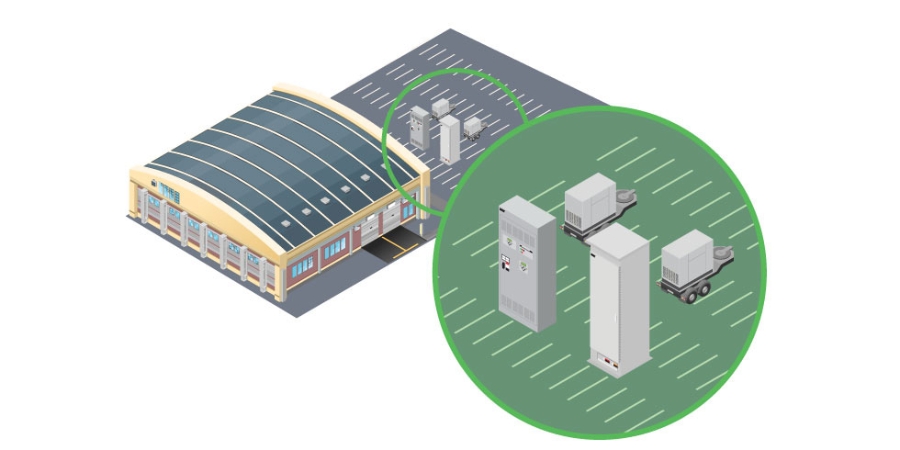As this piece was written, patient loads resulting from the continuing epidemic are filling medical facilities in the USA and around the world. What are the implications for backup power?
Hospitals
Capacity
In the US, there are approximately 2.8 beds for every 1,000 people. Typically, about two-thirds of beds are occupied at any time. Projected near-term increases in patients are filling or have filled hospitals to capacity. Over the coming weeks or months, hospitals will still be subject to outages from weather events and other causes, just as they typically are at any other time. When these Normal source outages occur, hospitals will rely on their backup power system to run life-safety, critical, and optional loads. In the coming weeks, hospitals and other medical facilities could be tested like never before. Because more people rely on these facilities, this would be the most inopportune time to lose back-up power. Consequently, testing activities should be up to date to identify generation capacity issues before they result in major problems. (Link to prior Tech Brief on the subject)
Changes in Usage
Experts forecast that the available beds in Intensive Care Units will be filled and that more will be needed. In some instances, temporary facilities are being erected in non-patient areas such as storage areas and lobbies. While authorities are relaxing regulation enforcement to promote the quick expansion, the power distribution systems in these temporary facilities will serve functions that are nevertheless critical.
Power distribution systems in traditional patient spaces are typically configured to the requirements of Article 517 of the National Electrical Code® and supplied with backup power. Electrical systems in commons spaces may not have been so provisioned. Even here, the need for backup power for critical devices such as ventilators must be considered. In addition, surge protection should also be considered to avoid impacts from transient overvoltage’s that could result from environmental events or internal sources associated with new electrical operations and circuits.
Urgent Care Facilities
Urgent care centers and other walk-in facilities are seeing more patients that require assessment. Given the volume of activity, these facilities form part of the “front lines” of healthcare system response, taking some of the burden that would otherwise fall on hospital emergency rooms. However, urgent care facilities and walk-in clinics are often housed in commercial structures that are not required to have backup power systems.
This could again pose a problem. If a public power outage occurs while these businesses assess patients, the facilities could lose power, forcing patients to go without care or seek care at already-burdened hospitals. Installing a backup power solution could prevent this outcome. Connection panels and small transfer switches can be installed quickly to provide a backup power solution.
Temporary Care Facilities
Some estimates suggest health officials could soon need to treat and quarantine large numbers of patients. The quantity of people is expected to exceed hospital capacity in affected regions. To meet the need, temporary medical facilities are being built in public spaces. Public buildings are also being converted for temporary care of large numbers of patients.
In February of 2020, the US Center for Disease Control issued guidance for designing temporary facilities, such as tent-based patient rooms, in its Considerations for the Use of Temporary Surge Sites for All-Hazards Incidents. Regarding backup electrical power, Page 15 directs this single question to the reader: “Is power supplied by generator or electrical connections? If using generator power, are you able to switch from one generator to another when they reach their hourly maximum capacity?” Quick deployment requires simple solutions. A transportable generator, a quick connect panel and manual transfer switch can go a long way in meeting basic backup power needs for simple facilities.
In converting public buildings, convention centers seem to be a favorite. Here’s a quote about one site in New York City:
"The Javits Center is an amazing facility .... Every 10 feet there's a great big steel door in the floor, you open it up in there is all the electrical; there's cold water, there's hot water and there's a place for sewers, so you can actually do things like sinks, right in the middle of a convention center to be able to make that happen."
“Make it happen,” indeed. Officials are planning on installing more than 2900 beds very quickly. Nevertheless, backup power must be considered for facilities like these. Existing backup electrical system capacity and features are likely consistent with whatever was required for life-safety systems and critical systems associated with the building’s originally proposed use. Because these spaces will become residential medical facilities administering critical care with ventilators and other electric-powered equipment, backup power is necessary for patient wellbeing. Supplemental power can be provided quickly by using pre-engineered transfer switches, either with or without quick connect panels. The following image shows the concept.
Backup Power for Temporary Patient Care Facilities


Does your organization need assistance with the particulars of providing backup power where there was none before? ASCO Power Technologies can help. Contact a local ASCO office or ASCO Customer Care at 800.800.2726 to speak with someone who can help identify a solution for your application.

